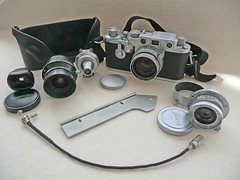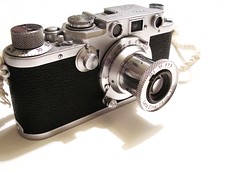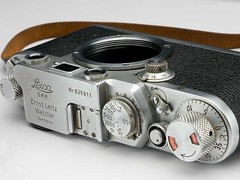Difference between revisions of "Leica IIIf"
m (correcting Collection Appareils link) |
Steevithak (talk | contribs) m (corrected some typos and grammer, photos, specs, and links) |
||
| Line 1: | Line 1: | ||
| + | The Leica IIIf was Leitz's first 35mm camera body for screw mount lenses with built-in flash synchronization. | ||
{{Flickr_image | {{Flickr_image | ||
|image_source= http://www.flickr.com/photos/74438997@N00/629438253/in/pool-camerawiki | |image_source= http://www.flickr.com/photos/74438997@N00/629438253/in/pool-camerawiki | ||
|image= http://farm2.static.flickr.com/1224/629438253_3b838d9b25.jpg | |image= http://farm2.static.flickr.com/1224/629438253_3b838d9b25.jpg | ||
|image_align= right | |image_align= right | ||
| − | |image_text= | + | |image_text= Leica IIIf |
|image_by= Mikel Parial | |image_by= Mikel Parial | ||
|image_rights=nc | |image_rights=nc | ||
}} | }} | ||
| + | ==Description== | ||
| + | The Leica IIIf was [[Leitz]]'s (later Leica) first [[35mm]] camera body for screw mount lenses with built-in [[flash sync|synchronization]]. It succeeded the Leica IIId, which was a rare variant of the [[Leica IIIc]]. Built-in synch means that, unlike its predecessors, the IIIf didn't need an optional rework for flash photography. But flash synchronization still needed an extra adjustment, a contact number between 0 and 20, which depending on the type of flash bulbs used. That was necessary since different types of bulbs needed different flash firing delay times for exact synchronization. | ||
| + | |||
| + | The camera has a couple rangefinder and a viewfinder designed for use with a 50mm lens. The camera has an M39 lens mount and cold shoe flash mount. | ||
| + | |||
| + | The camera appeared on the market in 1950. The Leica IIIf cameras are known as either '''Black Dial''' or '''Red Dial''' depending on the color of the engraved numbers on the syncronization dial. The original IIIf had black numbers. In 1952 or 1953, an upgrade to the shutter and flash sync system was carried out and the numbers were changed to red to indicate the new version. On the Red Dial version, the camera included better, more reliable shutter and had an improved flash sync speed of 1/50 of a second vs 1/30 of a second on the Black Dial versions. It was further upgraded with the addition of a [[self-timer]] in 1954. | ||
| + | |||
| + | Stanley Kubrick took a famous self portrait in a mirror using this camera while working as a staff photographer for LOOK Magazine. The photo is now part of the LOOK Magazine Photograph Collection residing in the US Library of Congress.<ref>[http://commons.wikimedia.org/wiki/File:KubrickForLook.jpg Wikimedia Commons, Self-portrait of Stanley Kubrick with a Leica IIIf camera]</ref> | ||
| + | ==Specifications== | ||
| + | * '''Badging:''' [[Leica]] | ||
| + | * '''Manufacturer:''' [[Leitz]] | ||
| + | * '''Lens mount:''' [[M39]] | ||
| + | * '''ISO:''' 25 - 3200 | ||
| + | * '''Shutter:''' cloth focal plane shutter | ||
| + | * '''Shutter Speeds:''' 1/1000 to 1 sec, Bulb | ||
| + | * '''Flash sync:''' 1/30 (Black Dial) or 1/50 (Red Dial) | ||
| + | * '''Focusing:''' Rangefinder | ||
| + | * '''Meter:''' none | ||
| + | * '''Battery:''' none | ||
| + | * '''Weight:''' 430 g (15.2 oz) | ||
| + | |||
| + | {{br}} | ||
| + | ==Photos== | ||
| + | {{Flickr_image | ||
| + | |image_source= http://www.flickr.com/photos/camerawiki/7404664938/in/pool-camerawiki | ||
| + | |image= http://farm9.staticflickr.com/8147/7404664938_135d9f44f0_m.jpg | ||
| + | |image_align= left | ||
| + | |image_text= Stanley Kubrick with Lecia IIIf | ||
| + | |image_by= Stanley Kubrick | ||
| + | |image_rights= pd | ||
| + | }} | ||
| + | {{Flickr_image | ||
| + | |image_source= http://www.flickr.com/photos/falleri/5809315266/in/pool-camerawiki | ||
| + | |image= http://farm6.staticflickr.com/5105/5809315266_7d07be89be_m.jpg | ||
| + | |image_align= left | ||
| + | |image_text= Leica IIIf | ||
| + | |image_by= Valerie Ardini | ||
| + | |image_rights= wp | ||
| + | }} | ||
| + | {{Flickr_image | ||
| + | |image_source= http://www.flickr.com/photos/falleri/5808752055/in/pool-camerawiki | ||
| + | |image= http://farm3.staticflickr.com/2219/5808752055_b79561f713_m.jpg | ||
| + | |image_align= left | ||
| + | |image_text= Leica IIIf | ||
| + | |image_by= Valerie Ardini | ||
| + | |image_rights= wp | ||
| + | }} | ||
| + | {{Flickr_image | ||
| + | |image_source= http://www.flickr.com/photos/polbar42/4271238706/in/pool-camerawiki | ||
| + | |image= http://farm3.staticflickr.com/2717/4271238706_c91b1d89d5_m.jpg | ||
| + | |image_align= left | ||
| + | |image_text= Leica IIIf with accessories | ||
| + | |image_by= polbar | ||
| + | |image_rights= wp | ||
| + | }} | ||
| + | {{Flickr_image | ||
| + | |image_source= http://www.flickr.com/photos/selva/15216920/in/pool-cameramania | ||
| + | |image= http://farm1.static.flickr.com/13/15216920_d3519816fa_m.jpg | ||
| + | |image_align= left | ||
| + | |image_text= Leica IIIf | ||
| + | |image_by= Eden Politte | ||
| + | |image_rights=nc | ||
| + | }} | ||
| + | {{Flickr_image | ||
| + | |image_source= http://www.flickr.com/photos/peterlerman/5194515611/in/pool-camerawiki | ||
| + | |image= http://farm5.staticflickr.com/4089/5194515611_5c1ef77242_m.jpg | ||
| + | |image_align= left | ||
| + | |image_text= Leica IIIf, top | ||
| + | |image_by= Peter Lerman | ||
| + | |image_rights= wp | ||
| + | }} | ||
| + | |||
| + | {{br}} | ||
| + | ==References== | ||
| + | <references/> | ||
| − | |||
== Links == | == Links == | ||
| − | |||
In English: | In English: | ||
| − | * [http:// | + | * [http://www.butkus.org/chinon/leica/leica_iiic/leica_iiic.htm Lecia IIIf Owner Manual] - from Butkus [[Orphan Cameras]] |
* [http://yandr.50megs.com/leica/3f/3f.htm Leica IIIf Owners Manual] | * [http://yandr.50megs.com/leica/3f/3f.htm Leica IIIf Owners Manual] | ||
* [http://www.kyphoto.com/classics/instructionmanuals.html Manual available on the Favorite Classics section of .kyphoto.com] | * [http://www.kyphoto.com/classics/instructionmanuals.html Manual available on the Favorite Classics section of .kyphoto.com] | ||
| + | * [http://ken.lyndrup.dk/Engelsk/Leitz%20E/Leica%20III%20F.htm Leica III f] Ken Lyndrups Collection of photo-corius [http://Ken.Lyndrup.dk/Engelsk.htm]] | ||
* [http://rick_oleson.tripod.com/index-154.html Opening a Screwmount Leica (IIIc or IIIf)] | * [http://rick_oleson.tripod.com/index-154.html Opening a Screwmount Leica (IIIc or IIIf)] | ||
* [http://www.pentax-manuals.com/manuals/service/leica_iiif.pdf Leica IIIf Repair Manual (PDF)], at [http://www.pentax-manuals.com/ Pentax Manuals] | * [http://www.pentax-manuals.com/manuals/service/leica_iiif.pdf Leica IIIf Repair Manual (PDF)], at [http://www.pentax-manuals.com/ Pentax Manuals] | ||
| Line 28: | Line 103: | ||
In Danish: | In Danish: | ||
* [http://ken.lyndrup.dk/Dansk/Leitz/Leica%20III%20F.htm Leica III f] Ken Lyndrups foto-raritetsskab [http://ken.lyndrup.dk/index.htm]] | * [http://ken.lyndrup.dk/Dansk/Leitz/Leica%20III%20F.htm Leica III f] Ken Lyndrups foto-raritetsskab [http://ken.lyndrup.dk/index.htm]] | ||
| − | |||
| − | |||
| − | |||
| − | |||
| − | |||
| − | |||
| − | |||
| − | |||
| − | |||
| − | |||
{{M39}} | {{M39}} | ||
Revision as of 00:44, 20 June 2012
The Leica IIIf was Leitz's first 35mm camera body for screw mount lenses with built-in flash synchronization.

|
| Leica IIIf image by Mikel Parial (Image rights) |
Description
The Leica IIIf was Leitz's (later Leica) first 35mm camera body for screw mount lenses with built-in synchronization. It succeeded the Leica IIId, which was a rare variant of the Leica IIIc. Built-in synch means that, unlike its predecessors, the IIIf didn't need an optional rework for flash photography. But flash synchronization still needed an extra adjustment, a contact number between 0 and 20, which depending on the type of flash bulbs used. That was necessary since different types of bulbs needed different flash firing delay times for exact synchronization.
The camera has a couple rangefinder and a viewfinder designed for use with a 50mm lens. The camera has an M39 lens mount and cold shoe flash mount.
The camera appeared on the market in 1950. The Leica IIIf cameras are known as either Black Dial or Red Dial depending on the color of the engraved numbers on the syncronization dial. The original IIIf had black numbers. In 1952 or 1953, an upgrade to the shutter and flash sync system was carried out and the numbers were changed to red to indicate the new version. On the Red Dial version, the camera included better, more reliable shutter and had an improved flash sync speed of 1/50 of a second vs 1/30 of a second on the Black Dial versions. It was further upgraded with the addition of a self-timer in 1954.
Stanley Kubrick took a famous self portrait in a mirror using this camera while working as a staff photographer for LOOK Magazine. The photo is now part of the LOOK Magazine Photograph Collection residing in the US Library of Congress.[1]
Specifications
- Badging: Leica
- Manufacturer: Leitz
- Lens mount: M39
- ISO: 25 - 3200
- Shutter: cloth focal plane shutter
- Shutter Speeds: 1/1000 to 1 sec, Bulb
- Flash sync: 1/30 (Black Dial) or 1/50 (Red Dial)
- Focusing: Rangefinder
- Meter: none
- Battery: none
- Weight: 430 g (15.2 oz)
Photos

|
| Stanley Kubrick with Lecia IIIf image by Stanley Kubrick (Image rights) |

|
| Leica IIIf image by Valerie Ardini (Image rights) |

|
| Leica IIIf image by Valerie Ardini (Image rights) |

|
| Leica IIIf with accessories image by polbar (Image rights) |

|
| Leica IIIf image by Eden Politte (Image rights) |

|
| Leica IIIf, top image by Peter Lerman (Image rights) |
References
Links
In English:
- Lecia IIIf Owner Manual - from Butkus Orphan Cameras
- Leica IIIf Owners Manual
- Manual available on the Favorite Classics section of .kyphoto.com
- Leica III f Ken Lyndrups Collection of photo-corius [1]]
- Opening a Screwmount Leica (IIIc or IIIf)
- Leica IIIf Repair Manual (PDF), at Pentax Manuals
- Servicing Screw Mount Leicas (PDF), at Pentax Manuals
In French:
- Leica IIIf at summilux.net
- Leica IIIf, IIIf with self-timer on www.collection-appareils.fr by Sylvain Halgand
In German:
- Leica IIIf story at Peter Lausch's [2]
In Danish:
- Leica III f Ken Lyndrups foto-raritetsskab [3]]